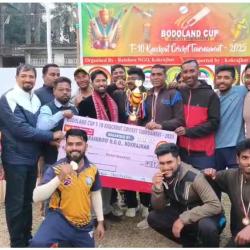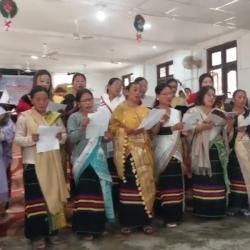“Amina was physically abused by her husband almost every day. The first few months after her marriage were not so difficult. She fell sick and gradually her health deteriorated. Her body battered by the illness and regular abuse could no longer withstand the hardship of doing the daily chores. She was too weak, too sick to do anything! She was coughing for weeks. One day, she saw blood coming out of her mouth with cough! She realized that something was very wrong with her body. She begged her husband, “Please do something! Take me to the hospital.” He hesitantly took her to the hospital. The doctor suggested the tests. After some days the results came and Amina was diagnosed with TB infection. Amina’s condition got worsened. Her husband was a daily wage earner. He needed Amina to cook his food and manage his house with his old mother. The doctor advised good food and rest for Amina. Her husband was not just ready or not capable to do anything extra for Amina’s treatment. No hope was left for Amina except going back to her maternal home!”- The DOTS provider narrated Amina’s sad story. He further reiterated that it is not only Amina who was abandoned by her husband, there are many who do not accept TB as treatable disease and above all they cannot take the burden of a TB patient who becomes unproductive for a long time!
Tuberculosis was once known as consumption disease because it causes severe weight loss. It is air borne and contagious. The symptoms of TB are coughing (often producing blood), fever, night sweats and chills. TB bacteria normally infects the lungs (called pulmonary), but it can also infect any other part of the body (called extra pulmonary). Malnourished people are particularly vulnerable to TB infection. Though TB is an ordinary disease, its impact is manifold. It can be treated and completely cured. Government of India provides DOTS treatment free of cost which is found to be the most effective. DOTS, i.e., Directly Observed Treatment Short courses are a package that entails six months rigorous follow-up. Two months intensive medicine and continuation course for four months. But it is dangerous if somebody does not take proper treatment because TB of the lungs spreads. A person with active TB infection can infect fifteen others in a year. It is also dangerous to stop the medicine midway during the course of treatment. It makes the bacteria stronger; it can also cause changes in the pattern of the disease. The person becomes resistant to drugs and invariably his life is put in danger and also his family and the society at large become susceptible to the disease. When a person doesn’t complete the course of antibiotics, the person develops multi-drug resistant TB. DOTS is a combination of four drugs. When a person doesn’t respond Isoniazid and Rifampicine, (he may or may not respond to anti TB drugs), it is termed as multi-drug resistant tuberculosis or MDR-TB. The MDR-B prevalence is estimated to be 2.3% among new cases and 12-70% among re-treatment cases. Due to the size of the population and the number of cases reported annually, India ranks second among the 27 MDR-TB high-burden countries in the world after China (WHO). DOTS plus treatment regimen (a grueling two years course) is recommended by the government for MDR-TB treatment which is given free of cost. In India, two people die in every three minutes from TB. Two million Indians develop TB each year. About a quarter of TB burden is borne by India. So, India is in the frontline of this global battle against TB. The connotation is- more the drug resistance; more the money must be spent on treatment. In case of India, national contributions provide the bulk of financing for TB care and control. In addition to that Global Fund, WHO, World Bank, USAID, BMGF, Union, etc. provide support and expertise for TB control.
The vicious cycle: A casual labour of Narayanpur tea garden stopped coming to take DOTS because he had to go to work. As an explanation he told, “I cannot come to take the medicine because I have to go to work. Who will feed me and my family if I do not work? It is one of the primary causes of not continuing the medicine for many people like him.TB primarily affects people in their productive age group i.e. between 15-54 years. On an average 3-4 months of work time is lost if someone gets infected by TB which entails in an average a potential loss of 20-30 % of annual household income (CLRA India). It can affect anyone with low immunity. Badly ventilated air conditioned office spaces in urban areas hold great risk of transmission of TB. The man woman ratio of pulmonary TB in India is 2:1. TB is also highly stigmatized. Many people are afraid to speak about the disease even to their own family members. Anyone with low immunity can be infected by TB bacilli. But TB is common among the poor because of low standards of hygiene and nutrition-which again causes low immunity among them. Malnutrition or malnourishment is one of the key causes of low immunity. Though malnutrition is present in all sections of society and economic groups, the poor and impoverished lot is more susceptible. The burden of the disease gets doubled in such families as a productive person becomes unproductive for a long period and s/he also requires extra care, nutritional diet besides the medicine. TB drugs are highly toxic and they frequently cause discomfort and acidity. Therefore, TB patients undergoing treatment must have proper diet and nutrition. A study conducted in 10 tea gardens under Dhekiajuli TB unit of Sonitpur district shows that, to have proper diet and nutrition during the course of treatment is a problem for the poor labourers. “Many TB patients tend to discontinue medication because their diet cannot provide them the strength to withstand the powerful antibiotics used for TB.” - Says Dr. Manik Roy, Medical officer in charge of Dhekiajuli TB unit. He added, “All of us are susceptible because 40% of the population is exposed to TB. It is a latent disease and becomes stronger in anybody with low physical immunity.” There are many risk factors like tobacco, HIV infection, diabetes, malnutrition, silicosis, malignancy, indoor air pollution, ventilation, crowding, urbanization, migration, poverty, etc. which may help the progression of latent TB to active disease.
Coming back to the story again, it is seen that the prevalence of TB is more among the tea garden labourers (including both registered and non registered) in the area under Dhekiajuli TB unit. Though no study is conducted till date, it is obvious that this particular section of population (tea garden labourers) in the state of Assam is vulnerable to many diseases due to causes known to all. They live in an atmosphere where concepts of proper sanitation, hygiene, nourishment etc are distant dreams. Their socio-cultural and economic condition is very much different from other communities of the state. Till the recent past, they were excluded from all development programmes on the pretext that the garden management is solely responsible for their wellbeing. But programmes like NRHM Assam, RNTCP, SSA etc has covered tea gardens too. NRHM Assam has provided services to the tea gardens through PPP mode of programme implementation. Earlier, tea garden management had to provide treatment to TB patients free of cost. The cost of a DOTS course is about Rs.15000/- . After the intervention of RNTCP tea garden managements got rid of the huge expenses (Rs. 15,000/- per head for each TB patient) because DOTS treatment has been made free for tea gardens too. It is an overall feeling on the part of people who are dedicated to treat TB patients and are actively engaged on the field in this pursuit that DOTS beneficiaries of tea gardens must get an aid from the tea garden management during the tenure of DOTS treatment for diet and necessary supplements. TB treatment and control would gain a boost if a financial assistance can be provided to the patient for taking good food. The tea gardens may divert the fund for such welfare schemes which would have been otherwise spent on TB treatment. A financial assistance for six months to every patient to ensure his nutrient intake may be introduced by the tea gardens. If it succeeds, the state government may take up for all Tb patients in the state. Such initiative will not only stop defaults of DOTS but also will decrease the risk of MDR-TB at the same time, abusive cases like Amina and stigma associated with TB will no longer exist. In the same line, many of the service providers and families battered by TB feel that there is a need for communication strategies for constant hammering and repetitive warning of TB control, about the role of community as well as individual efforts etc. They love TV and cinema. These medium should be used extensively for communication.The tea gardens may come up with an example in this respect and pave a way for the government and other donors. TB must be contained. We cannot put our younger generations at the risk of MDR or XDR TB.
- 16530 reads










Add new comment